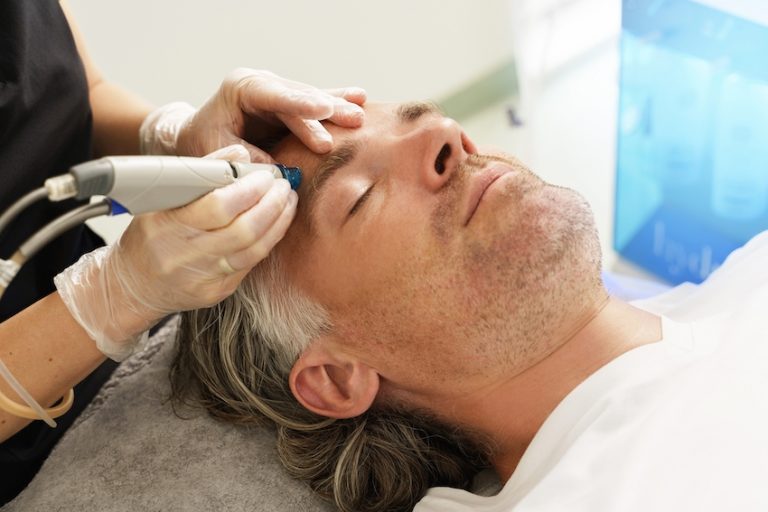HYDROFACIAL
Treat yourself to the best hydrofacial treatments in the South for regenerated, radiant and youthful skin
Best Hydrofacial Treatments in Columbus
Southeast Regional Med Spa provides the best hydrofacial treatments near Columbus, GA. Hydrofacial treaments are simply amazing. Do you have problems with wrinkles, sun damage, acne, or brightening? Hydrofacial treatments improve radiance, hydration, skin texture, and youthful appearance.
With hydrofacials, we use a mildly abrasive instrument to gently sand your skin and inject boosting serums, removing the thicker, uneven outer layer and suctioning and removing dead skin cells along the way. Your skin will feel deliciously regenerated and softer to the touch.
Hydrofacial Treatments - Services and Prices
If you are a first time patient and aren’t sure which of our hydrofacial services are right for you, we can answer any questions you might have in your first session.
Standard
Basic Hydrofacial-
The basic hydrofacial helps to improve skin texture, tone, and appearance. The deep exfoliation cleans your pores to get rid of debris. This allows for better absorption of face serums and your makeup to look visibly smoother. HydroFacial treatments use hydro microdermabrasion to gently hydrate and rejuvenate the skin.
Acne
-
Acne hydrofacials help unclog pores that may be preventing you from having clear skin. The treatment targets dead skin cells that can mix with sebum to produce unwanted bacteria on your skin. Besides unclogging pores, this treatment is also great for treating hyperpigmentation and scarring.
Anti-Aging
-
Undergoing regular hydrofacials can result in reduced fine lines and wrinkles over a period of time. The anti-aging hydrofacial is a great way to keep your skin and pores clean in order to have lasting younger-looking skin.
Dermaplane
-
Dermaplaning is a skin treatment that uses an exfoliating blade to scrape dead skin cells and hair from the uppermost layers of your skin. This treatment is often used for making the skin smoother, softer, and brighter. Dermaplaning is the best alternative to shaving your face and allows the hair to grow back less often.
Referral Program for Botox or Dermal Filler Services
If you are a hydrofacial client and would like to try one of our botox or dermal filler services, we offer a referral program.
All toxins, fillers and most services and skincare have a loyalty program in our office with cash rewards used or issued with every session, treatment, or purchase.
We have a referral program for all patients that refer a filler or toxin patient to our med spa.
You will receive a $20 credit for every referral. Simply have the new patient let our staff know when they make an appointment your name and email address so we can follow up with your referral credit!

Hydrofacial Services FAQ's
A hydrofacial treatment is a non-surgical procedure that rejuvenates the skin, creating a radiant look by improving the appearance of wrinkles, acne, oily skin, and lines.
A hydrofacial treatment enhances your skin by resurfacing it; it removes dead skin cells and infuses healthy serums and moisture into your skin layer to give it a healthy, more youthful appearance. It helps reduce the dullness of skin and make you look younger, while also addressing environmental damage and the associated effects of aging. It’s like a full refresh for your skin which leaves it smooth and soft.
The typical hydrofacial appointment takes about 30 minutes.
Our hydrofacial prices are very affordable and are listed on this page, just scroll up to learn more.
Within 48 hours prior to treatment, refrain from the use of any over-the-counter acne medications, such as benzoyl peroxide or salicylic acid. Avoid waxing and the use of depilatories. Refrain from any type of exfoliating treatments. Keep your face clean.
No! We have not had a client ever tell us a hydrofacial treatment was painful the sensation is distinct but not painful and the results speak for themselves.
Yes, but it is not recommended that you do so immediately after the treatment. Give it some time (see the next question and answer for more detail).
You can return to normal activities, but it is best to follow the following instructions:
Keep your face unwashed for around 6-8 hours after your hydrafacial treatment, and try to avoid intensive activity that may cause sweating. The optimal action is to keep your face dry to protect your skin and achieve the best results from the hydrofacial.
Our standard “hydrofacial treatment pack” is a three-area session–$13 per unit includes between the Eyes, Forehead, and Crow’s Feet. This session includes a follow-up at no charge for additional botox if it is needed. Our prices are very affordable so we don’t offer a hydrofacial treatment pack, as in multiple sessions for one price. Each hydrofacial works, so you may not need many sessions.
Southeast Regional Med Spa is known to provide the best hydrafacials in Columbus because in addition to providing medically supervised services for all of our clients, we have the best technically skilled staff of any med spa in the South.
We care deeply about our clients, have a light touch, and offer a fun and supportive environment for you to enjoy with each visit. Check out some of our reviews and you will see the type of feedback we are given by clients.
